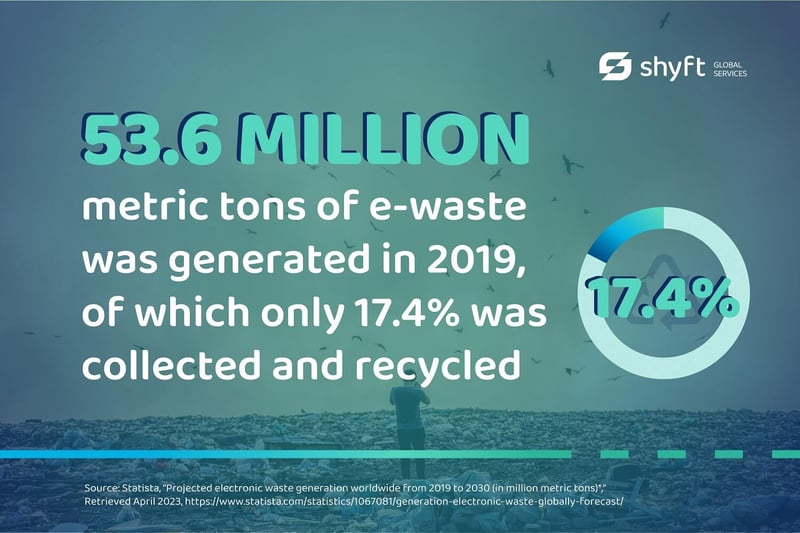The Dark Side of Electronic Devices:
What You Need to Know About the E-Waste Crisis
From Creator to Problem Solver: How Technology Companies Can Tackle the E-Waste Crisis
The world is facing a growing e-waste crisis, and its impact on the environment threatens to be devastating. The continual demand for electronic devices leads to mounting quantities of discarded items. This “take-make-waste” scenario harms the environment, causing soil and water contamination, air pollution, increased greenhouse gas emissions and reduced landfill space. While the severity of the e-waste crisis swells, technology companies are in a prime position to confront this challenge and improve environmental sustainability.
1What is Considered
E-Waste?
What is considered e-waste and what makes it harmful to the environment? How much e-waste is produced each year?
2Technology Companies and the E-Waste Crisis
Technology companies play a significant role in the product lifecycle. What challenges do they face in addressing the e-waste crisis?
3Where Does
E-Waste End Up?
What happens to e-waste? What alternative disposal methods can help reduce the environmental impact of e-waste?
4Benefits of Proper
E-Waste Recycling
What are the key benefits of proper e-waste recycling? How are technology companies already contributing to sustainability, environmental protection and resource conservation?
5Solutions for Technology Companies
to Tackle the E-Waste Crisis
How can technology companies tackle the e-waste crisis cost-effectively? Accepting responsibility is the first step toward building a cleaner, healthier environment for us all.
What is Considered E-Waste?
To address the problem the world faces from obsolete electronic devices, it's necessary first to determine what is considered e-waste. This term includes discarded electrical or electronic devices such as:
- Smartphones
- Laptops
- Monitors
- Printers
- Other computer equipment
- Household appliances
- Televisions
- Medical devices
- And more
E-waste contains potentially hazardous materials such as lead, beryllium, mercury and cadmium, which can cause significant environmental damage and health hazards.
How Much E-Waste is Produced Each Year?
The rapid expansion of convenient, leading-edge technology paired with the drive toward consumption-based models to accommodate demand results in the generation of a very large amount of e-waste.
Globally, an estimated 53.6 million metric tons of e-waste was generated in 2019, of which only 17.4% was collected and recycled. The rest ends up in landfills, where decomposing can take centuries. Previously, personal computers and televisions were the primary contributors to e-waste, but mobile phones and other handheld devices have become the dominant sources in recent years. The quantity of e-waste generated annually is projected to soar to 74.7 million metric tons by 2030. The Asia-Pacific region accounts for the largest share of e-waste generated, followed by the Americas and Europe, respectively.

Technology Companies and the E-Waste Crisis
Technology companies play a significant role in both the production and disposal of electronic devices, which means they are well positioned to significantly impact the e-waste crisis — either positively or negatively. However, they face numerous challenges in addressing the issue:
 Designing for Disposal
Designing for Disposal
Many electronic devices are not designed for easy disassembly and recycling, making it challenging to recover valuable materials and properly dispose of hazardous materials. In a study conducted by the Basel Convention, 75% of respondents identified design for disassembly and recyclability as the most critical factor in addressing the e-waste crisis.
 Absence of Incentives
Absence of Incentives
Outside of creating a more sustainable world for future generations, there is seldom a financial or regulatory incentive for technology companies to design products with end-of-life considerations. A European Environmental Bureau (EEB) study notes that some companies use design tactics such as non-changeable batteries to discourage repair and promote replacement rather than repair.
 Consumer Participation
Consumer Participation
While two-thirds of consumers seek out eco-friendly brands, the majority are unaware of the importance of proper e-waste disposal and do not prioritize it when disposing of their own electronic devices. In a survey by the Consumer Technology Association, 40% of respondents admitted to throwing away electronic devices instead of recycling them, compared with only 18% who "always recycle."
 Lack of Regulation
Lack of Regulation
In some regions, there is a lack of regulatory frameworks and enforcement of e-waste management, making it more difficult for technology companies to implement effective recycling practices. However, many organizations are working to reduce and manage e-waste by implementing sustainable practices for product design, repair services and IT asset disposition.
Where Does E-Waste End Up?
E-waste frequently ends up in landfills, incinerators or recycling facilities. Sometimes, these locations are unauthorized and operated by untrained workers. Processing e-waste without proper protective measures can lead to hazardous chemical exposure and severe health problems for workers, the surrounding community and the world overall. Improper e-waste disposal also causes air pollution and environmental damage, highlighting the importance of finding alternative methods.
Alternative E-Waste Disposal Methods
There are several alternative disposal options for e-waste that can reduce the environmental impact of electronic devices. Some methods individuals and organizations can dispose of their electronic devices responsibly include:
- Compliant e-cycling, which involves sending e-waste to a certified e-cycling facility, where it is properly disassembled, and valuable materials can be recovered for reuse
- Repair, which extends the lifespan of devices — the more equipment you repair, the less you need to create or use, helping to keep e-waste out of landfills
- Donating old but functioning electronic devices to schools, shelters, nonprofits or other organizations to help extend technology lifespan and reduce the amount of e-waste generated
- Buyback and trade-in programs in which customers can conveniently return their old devices for proper, authorized recycling and receive a discount on a new device
How E-Waste is Recycled
The goal of e-waste recycling is to prevent hazardous materials from being released into the environment. The e-waste is collected and transported to a recycling facility and sorted into categories. The specific recycling process varies depending on the type of electronic device and its materials. Generally, devices are disassembled into individual parts, and components are shredded or crushed into small pieces. These are separated by material (such as plastic, metal, and glass), cleaned to remove contaminants, and processed to create new products or materials. Additionally, if needed, recycling may include a data sanitization or data erasure process to protect potentially sensitive information that may be stored on the device.
Advancements in E-Waste Recycling Technology
Advancements in e-waste recycling technology have made it possible to recover a greater percentage of valuable materials from electronic devices and reduce the environmental impact of e-waste. Some advancements include:
- New technologies to separate different materials in e-waste, such as plastic, metal and glass
- Chemical processes that extract valuable metals such as gold and silver from e-waste
- Biometallurgy, which uses microorganisms to recover metals from e-waste
- Repairing electronic devices to extend the product lifespan and lifetime value and reduce e-waste
- Green design processes with end-of-life considerations, such as devices that last longer and are easier to repair or recycle when they approach the end of life
These advancements in e-waste recycling technology are helping to create a more sustainable and circular economy in which valuable materials are recovered and reused rather than wasted.
 Environmental Protection
Environmental Protection
E-waste contains hazardous materials that leach into soil and water if not properly disposed of. Recycling e-waste reduces the amount of these hazardous materials that end up in landfills and reduces the risk of environmental contamination.
| Case in Point: Google committed to using recycled materials in all its hardware products by 2022. It also offers a trade-in program and works with e-waste recyclers to ensure responsible disposal. In 2020, Google reported recycling over 2.5 million pounds of electronic waste through its trade-in program. |
 Resource Conservation
Resource Conservation
Electronic devices also contain valuable materials that can be recovered and reused in new devices. Proper e-waste recycling allows for the recovery of these materials, decreasing the need for new raw materials to be mined and reducing the strain on natural resources.
| Case in Point: Samsung has implemented sustainable, eco-conscious packaging, which uses materials manufactured using environmentally friendly processes in its product packaging. Additionally, the company reported that it had recycled over 236,000 tons of electronic waste in 2020 alone. |
 Job Creation
Job Creation
The e-waste recycling industry creates new jobs in collection, transportation and recycling, which provides economic benefits to communities and helps to stimulate local economies.
| Case in Point: Dell has a closed-loop recycling process and a trade-in program to ensure responsible disposal. In 2020, Dell reported that it had recycled over 2 billion pounds of electronic waste since the inception of its recycling program in 2007, creating over 1,500 jobs worldwide in the process. |
 Energy Savings
Energy Savings
Recycling e-waste requires less energy than mining new raw materials and manufacturing new electronic devices. This can lead to significant energy savings and reduced greenhouse gas emissions.
| Case in Point: HP has a free recycling program called HP Planet Partners, operating in over 70 countries. It uses recycled ocean-bound plastic in its ink cartridges and designs products for disassembly to make recycling easier. |
 Data Security
Data Security
Proper e-waste recycling ensures sensitive data stored on electronic devices is securely erased, reducing the risk of data breaches and identity theft.
| Case in Point: Apple's e-waste recycling program includes a data security process that involves the secure erasure of all device data using specialized software. In cases where the device cannot be wiped, physical destruction techniques ensure sensitive information is not retrievable. Apple also offers a trade-in program for customers to return their old devices for proper recycling, which has diverted over 861,000 metric tons of e-waste since 2015. |
Solutions for Technology Companies to Tackle the E-Waste Crisis
In the never-ending drive to create the “next big thing” in technology, original equipment manufacturers (OEMs) play a crucial role in the lifecycle of electronic devices. But to limit their impact on the environment, they must go beyond simply manufacturing to consider what happens to the technology as it approaches the end of the lifecycle. Being part of the solution to curb the e-waste crisis should include:
- Encouraging proper e-waste disposal across your network — including end users, employees, suppliers, partners and other stakeholders — to protect the environment and public health
- Enforcing responsible disposal practices, which demonstrates your commitment to sustainability and social responsibility, preserves brand reputation and attracts environmentally conscious consumers and investors
- Participating in the circular economy, which can reduce disposal costs and create new revenue streams through the recovery and reuse of valuable materials
- Minimizing your carbon footprint with a closed-loop supply chain, more sustainable packaging, optimized inventory and a strategic warehouse footprint
Implementing sustainable product design, repair and IT asset disposition practices enables technology organizations to reduce their environmental impact effectively, comply with regulations and promote sustainability.
How to Address E-Waste Cost-Effectively
Technology companies can address the e-waste crisis cost-effectively by designing products with end-of-life considerations in mind, offering convenient repair and disposal programs and developing closed-loop supply chains that use recycled and/or reusable materials. But knowing where to start can be a challenge in itself. An experienced service and logistics partner can help navigate the obstacles associated with supply chain management, forward and reverse logistics, depot repair services, IT asset disposition, the end-to-end technology lifecycle and more.
By collaborating with like-minded partners to minimize e-waste management costs and increase the recovery of valuable materials, technology companies can confront the e-waste crisis head-on while also improving their bottom line.
A Serious Responsibility
Technology companies should own their responsibility for the e-waste crisis by promoting safe disposal methods among their users, implementing sustainable product design practices and supporting best practices for repair, recycling and disposal services.
Accepting responsibility is the first step. Take action today to begin implementing ways to support actionable sustainability and promote a greener and more responsible way of living that benefits everyone.




